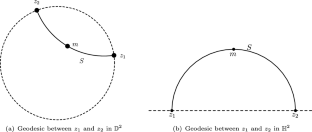Computational and Applied Mathematics ( IF 2.998 ) Pub Date : 2024-04-21 , DOI: 10.1007/s40314-024-02652-3 Érika Patrícia Dantas de Oliveira Guazzi , Reginaldo Palazzo Júnior

|
This paper presents the conditions under which a coded digital communication system’s performance may be improved using better signal sets design matched to groups. This improvement is directly related to the determination of the uniformization region of a hyperelliptic curve by using a Fuchsian differential equation and, consequently, the determination of the Fuchsian group and subgroup generators. The hyperelliptic curves of interest are given by \(y^2=z^n \pm 1\), where \(n\in I\!\!N\) and \(n=2g+1\) or \(n=2g+2\), and satisfy the following conditions: all the roots are distinct, they are symmetrically arranged (regular polygon) in the Poincaré disk, the juxtaposition of two such polygons gives the uniformization region. These conditions imply that the uniformization regions are regular polygons and that the associate Fuchsian group leads to regular tessellations from which arithmetic Fuchsian groups may be found. This work aims to answer and establish the conditions for the following questions: Can Fuchsian subgroups corresponding to two distinct hyperelliptic curves with the same degree and genus be isomorphic in \({\mathbb {D}}^2\) as well as in \({\mathbb {H}}^2\)? What are the conditions under which an isometry acting on isomorphic Fuchsian subgroups in \({\mathbb {D}}^2\) remain isomorphic in \({\mathbb {H}}^2\)? To show the isomorphism, we use the concept of conjugation. The first question’s positive response is achieved for hyperelliptic curves given by \(y^2 = z^n \pm 1\). Finally, from the results established in \({\mathbb {D}}^2\) and \({\mathbb {H}}^2\), if the Fuchsian subgroups are isomorphic by conjugation in \({\mathbb {D}}^2\), they remain isomorphic in \({\mathbb {H}}^2\) by the action of an appropriate isometry as established in Theorem 3 and its generalization in Theorem 4.
中文翻译:

关于 $${\mathbb {D}}^2$$ 和 $${\mathbb {H}}^2$$ 中 Fuchsian 群同构的超椭圆函数性质和等距
本文介绍了使用与组匹配的更好的信号集设计可以提高编码数字通信系统性能的条件。这种改进与使用 Fuchsian 微分方程确定超椭圆曲线的均匀化区域以及因此确定 Fuchsian 群和子群生成元直接相关。感兴趣的超椭圆曲线由\(y^2=z^n \pm 1\)给出,其中\(n\in I\!\!N\)和\(n=2g+1\)或\( n=2g+2\),并且满足以下条件:所有根都是不同的,它们在庞加莱盘中对称排列(正多边形),两个这样的多边形的并置给出了均匀化区域。这些条件意味着均匀化区域是正多边形,并且关联的 Fuchsian 群导致规则的镶嵌,从中可以找到算术 Fuchsian 群。本工作旨在回答并建立以下问题的条件: 对应于两条具有相同次数和属数的不同超椭圆曲线的 Fuchsian 子群能否在\({\mathbb {D}}^2\)以及\ ({\mathbb {H}}^2\) ?在什么条件下作用于\({\mathbb {D}}^2\)中同构 Fuchsian 子群的等距在\({\mathbb {H}}^2\)中保持同构?为了表明同构,我们使用共轭的概念。第一个问题的正响应是通过\(y^2 = z^n \pm 1\)给出的超椭圆曲线实现的。最后,根据\({\mathbb {D}}^2\)和\({\mathbb {H}}^2\)中建立的结果,如果 Fuchsian 子群通过共轭而同构于\({\mathbb { D}}^2\) ,通过定理 3 中建立的适当等距作用及其在定理 4 中的推广,它们在\({\mathbb {H}}^2\)中保持同构。



























 京公网安备 11010802027423号
京公网安备 11010802027423号